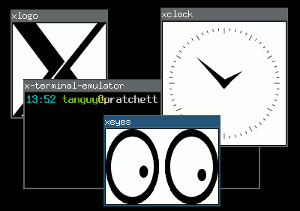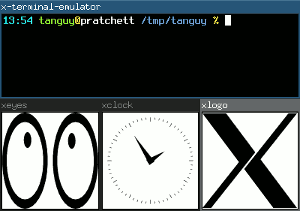Mutt: encrypt all messages sent to known PGP users
Classified in : Homepage, Debian, Command line, To remember

This is one thing I have wanted to do for a long time: configure Mutt to encrypt all messages sent to addresses for which I have a valid public key. Well, here is an awk-based script to generate that configuration.
(Yes, I know, a similar script was already written. But I did not see it at first, and I find mine more readable. :-) )
Read more Mutt: encrypt all messages sent to known PGP users
Tiling window managers
Classified in : Homepage, Debian, Command line
Floating and tiling window managers
In the X Window System, the window manager is that piece of software that places your windows and allows you to move them, resize them, hide them, etc. If your windows have titles on top of them, with buttons to close them or reduce them, it is thanks to the window manager. There are two major types of window managers:
- Floating window managers
- They are the most usual window managers, that allow you to place an size your windows freely on the screen, in a way where they are independent of each other, possibly overlapping, just as you would be able to place sheets of paper on your desk.
- Tiling window managers
- They are a more elitist type of window manager, that adjust the size and position of the windows so there is no overlapping and no space lost between windows, thus tiling the screen.
The frontier between these two types is not very tight, because some floating window managers have limited tiling features, and almost all the tiling window manager have floating modes for programs that are not adapted to tiling.
For what it is worth, here is a report on my experience with three tiling window managers. Perhaps it may help people that are still hesitating to switch to tiling window management?
About system host names
Classified in : Homepage, Debian, Miscellaneous, To remember
The host name
On Unix systems, the host name is kept in memory by the kernel: it is set
and get by the sethostname() and gethostname()
functions and their command-line wrapper hostname(1). It can be
used by several programs, for instance by the mail server to determine what it
should use as its HELO name.
In fact, the host name has two forms: the short one and the fully qualified one. For instance, a host can have muscadet as its short name muscadet and muscadet.example.com as its fully qualified one. From these two forms, a third information can be deduced: the domain name, which is the full name without its first component.
The system host name can be set as either the short name or the fully qualified name. When the full name is used, the short one can be easily deduced, by keeping only its first component. When the short name is used, the full name must be determined by using a more complex heuristic that takes more time and can fail for several reasons.

